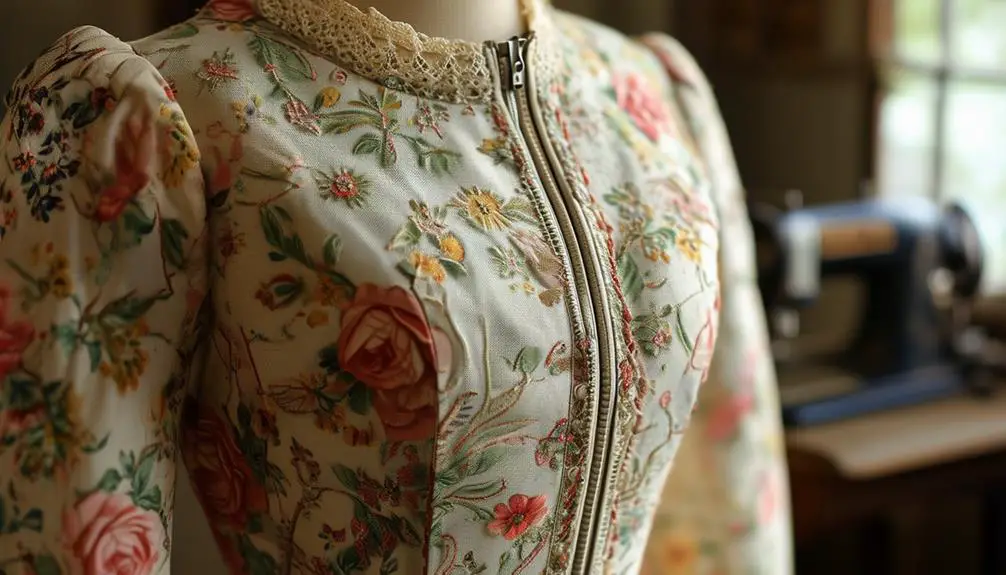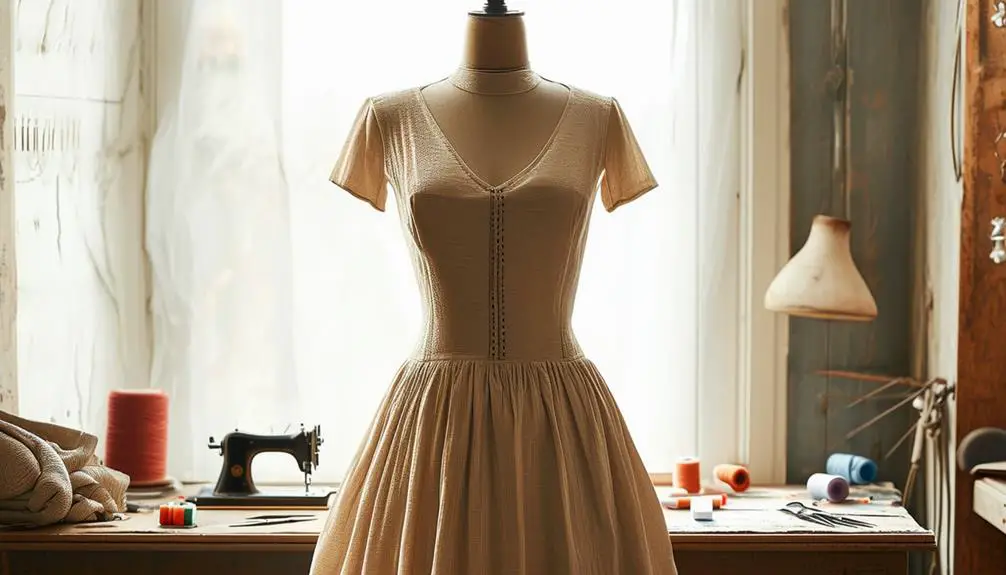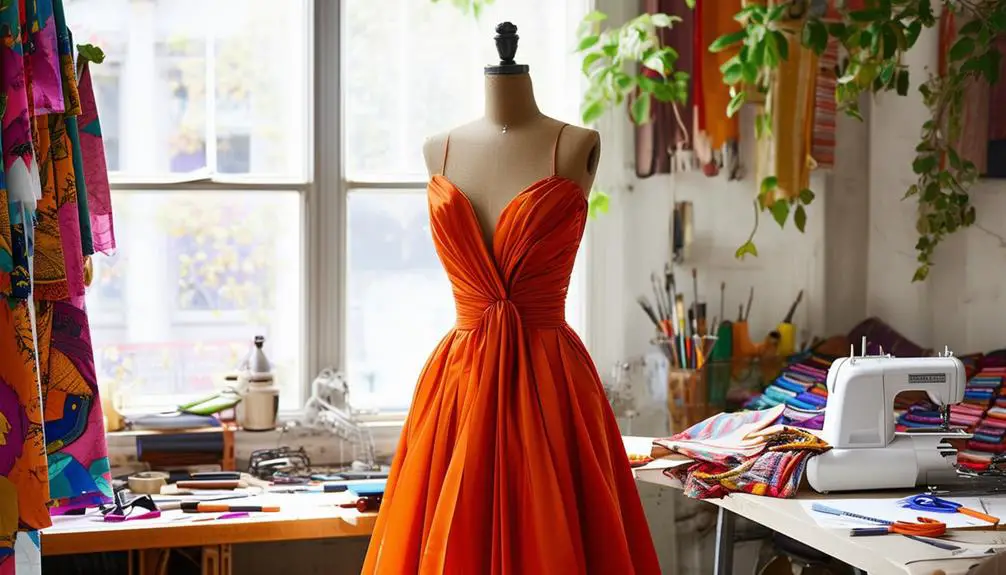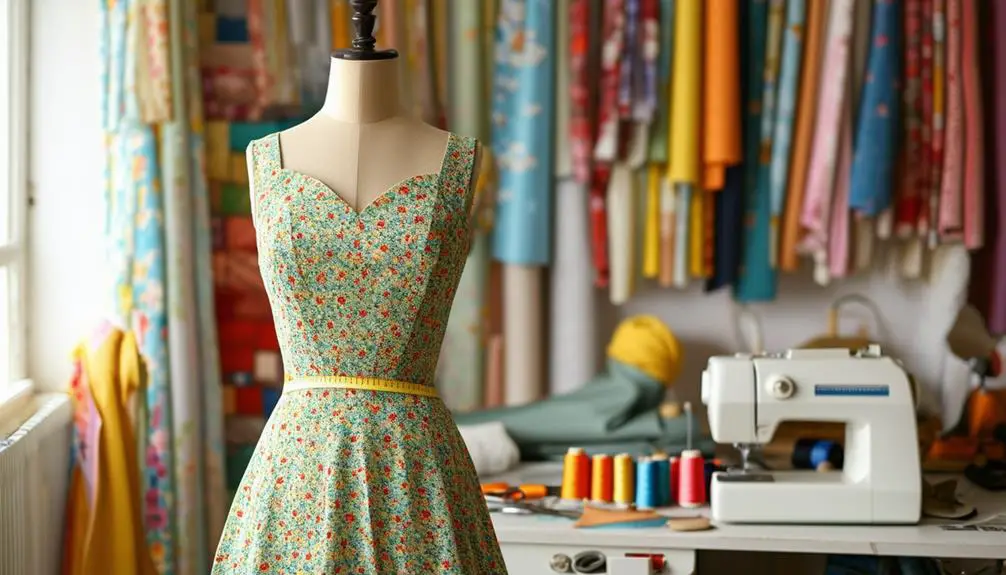To tailor a vintage sheath dress, start by trying it on to pinpoint areas needing adjustments, like armholes and side seams. Use chalk or pins to mark these changes, ensuring symmetry. To enhance comfort, consider adjusting tight shoulders and underarm areas. When cutting excess fabric, leave a half-inch seam allowance for future tweaks. Finish raw edges with a zigzag stitch to prevent fraying. Once your alterations are complete, meticulously sew along the marked lines and trim any extra fabric. This process not only revitalizes your dress but also elevates its style, setting the stage for more detailed techniques ahead.
Vintage Dress Characteristics

Vintage sheath dresses typically showcase a structured silhouette that sets them apart from modern styles. You'll notice the tight shoulders and armholes, which can restrict movement. This design emphasizes a fitted look, making vintage dresses less forgiving for varying body shapes.
If you find a vintage shirt dress that you adore, remember that its charm often lies in the details, such as unique vintage clothing labels that provide insights into the era and brand. Gingham prints, for instance, add a classic aesthetic, enhancing the dress's appeal.
The longer skirt cuts of vintage dresses have made a comeback in today's fashion, showcasing their timelessness. When you slip into a vintage sheath, pay attention to the side seams; they're essential for creating that flattering fit.
If you find the dress too snug around the right sleeve, it might need some adjustments to guarantee comfort without sacrificing style.
Personal Alteration Journey
While maneuvering through the domain of vintage fashion, you might find that even the most charming sheath dress can feel a bit off once you try it on. After initial hemming, your dress may still lack that perfect fit, making it a candidate for some personal alterations.
To begin your journey, put on the dress and mark a new armhole position. Remember to account for the seam allowance in your final cut. This essential step helps guarantee a comfortable and tailored fit. You'll love how the new armhole transforms the silhouette!
Once you've cut the new armhole, finish the edges with bias binding. This technique not only provides a polished look but also prevents fraying. The alterations aim to turn your boxy dress into something you can wear confidently throughout the summer.
Here's a quick reference table to summarize your journey:
| Step | Action Taken | Outcome |
|---|---|---|
| Initial Hemming | Adjusted length | Improved fit |
| New Armhole Marking | Marked for comfort | Better silhouette |
| Edge Finishing | Used bias binding | Clean finish |
| Final Result | Turned out great | Frequent wear ready |
Effective Alteration Techniques

Once you've made those initial alterations, it's time to focus on effective techniques that will further refine your vintage sheath dress. Vintage pieces, like those from Betty Barclay, are known for their quality craftsmanship and stylish designs, so you want it to fit just right.
Follow these steps to guarantee a polished finish:
- Try it on: Assess areas needing adjustment, particularly side seams, armholes, and sleeves.
- Clean edges: Use a serger, zigzag, or overcast technique to clean up raw edges before making alterations. This step guarantees a neat finish.
- Mark alterations: Use chalk or pins to mark your desired changes, taking precise measurements to maintain symmetry. Remember, you don't want to make the garment too small.
- Adjust seams: Take in the side seams and underarm areas for a snug fit. You might also consider adjusting the back princess lines for that tailored silhouette.
After sewing along the marked lines, cut off the excess fabric while leaving a half-inch seam allowance. This allows for any future adjustments, which is actually really important if your body changes over time.
With these techniques, you'll achieve a stunning, custom-fit vintage sheath dress!
Fashion Impact of Tailoring
When you tailor a sheath dress, you're not just altering a piece of clothing; you're transforming it into a personal statement that speaks to your unique style. Tailoring enhances the fit, turning an unflattering silhouette into a form-fitting design that accentuates your body's shape. This improvement not only boosts your comfort but also gives you greater freedom of movement, eliminating those pesky tight shoulders and restrictive armholes common in original designs.
Moreover, customization aligns your vintage dress with current fashion trends, such as longer skirt cuts and tailored silhouettes. By reinvigorating neglected pieces, you make them more wearable in contemporary settings, ensuring they become staples in your wardrobe.
Here's a quick overview of the fashion impact of tailoring:
| Benefit of Tailoring | Fashion Trend Connection | Personal Style Enhancement |
|---|---|---|
| Improved fit | Tailored silhouettes | Unique customization |
| Greater comfort | Longer skirt cuts | Reflects your taste |
| Sustainability | Eco-friendly fashion | Timeless pieces revived |
| Increased wearability | Modern styling | Versatile outfit options |
Community Feedback and Engagement

Engaging with the community around vintage sheath dress tailoring can greatly enhance your refashioning journey. By sharing experiences and gathering feedback, you'll not only improve your skills but also inspire others.
Understanding the importance of vintage tag identification can also provide context for the garments you're working on. Here's how you can actively participate:
- Share Progress Pictures: Post updates throughout your tailoring process. Visual references help others understand common challenges and solutions.
- Leave a Comment: Join conversations in forums or social media groups. Your input can lead to valuable exchanges of tips and techniques.
- Seek Feedback: Ask the community for thoughts on specific adjustments. Highlighting areas like fabric pinch between the bust and shoulder can lead to insightful advice.
- Celebrate Others' Successes: Acknowledge fellow crafters' achievements. This fosters a supportive atmosphere, encouraging everyone to push their creative boundaries.
The positive feedback from the community shows how effective these interactions can be for improving your vintage garment alterations.
By engaging in community interaction, you'll find a wealth of knowledge and encouragement, making your tailoring experience even more rewarding.
Finalizing the Dress Fit
After gathering valuable insights from the community, it's time to focus on finalizing the fit of your vintage sheath dress. Start by ensuring that all adjustments are marked and pinned accurately. For instance, lower the bust darts and add seam allowances to the waist. You'll want to place the fabric right sides together to check for any pinch from the bust to the shoulder—adjust as needed for comfort and style.
Next, assess the sleeve fit. You may need to raise elbow darts and reduce any excess fabric above the elbow. This helps create a sleek silhouette that complements your figure. Don't forget the skirt design; consider the desired length and peg shape, as these can dramatically alter the overall look.
Once you've made the necessary adjustments, meticulously sew along the chalk-marked lines. Trim any excess fabric, leaving a half-inch seam allowance for a polished finish.
Here's a quick reference table to keep track of your adjustments:
| Adjustment Type | Action Required |
|---|---|
| Bust Darts | Lower as needed |
| Sleeve Fit | Raise elbow darts |
| Waist Seam Allowance | Add for better fit |
| Skirt Length | Finalize desired length |
Frequently Asked Questions
Can You Alter a Vintage Dress?
Absolutely, you can alter a vintage dress! Adjusting seams, armholes, and sleeves enhances fit, making it uniquely yours. Just remember to contemplate your current body measurements and preferences for a modern, comfortable look.
What Body Type Looks Good in a Sheath Dress?
If you've got an hourglass figure, a sheath dress will showcase your curves beautifully. Pear-shaped bodies shine in structured designs, while athletic shapes benefit from details that create the illusion of curves. Everyone can rock it!
How to Make a Sheath Dress More Casual?
To make your sheath dress more casual, layer it with a denim jacket, swap heels for sneakers, and accessorize with a slouchy bag. Playful prints and bright colors can enhance its vintage charm effortlessly.
Are Sheath Dresses Still in Style?
Yes, sheath dresses are still in style! Their fitted silhouette flatters various body types, making them perfect for any occasion. You'll find them updated with fresh fabrics and patterns, ensuring you look chic and timeless.





Can you be more specific about the content of your article? After reading it, I still have some doubts. Hope you can help me.
Thank you for your sharing. I am worried that I lack creative ideas. It is your article that makes me full of hope. Thank you. But, I have a question, can you help me?
I like this website because so much utile stuff on here : D.